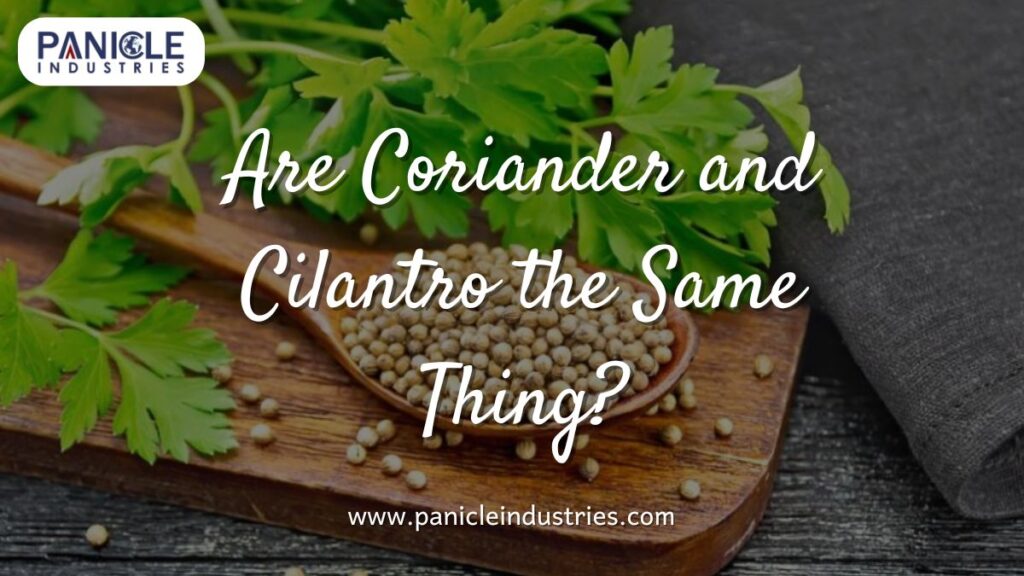When exploring herbs and spices in cooking, many people ask, are coriander and cilantro the same thing? This question often creates confusion, especially when recipes from different countries use different terms for what seems to be the same ingredient. While coriander and cilantro come from the same plant, they refer to different parts of it. The terms also vary depending on whether you are in the United States, the United Kingdom, or another region. Understanding this difference can help avoid mix-ups in the kitchen and improve your cooking skills.
In this blog, we will clearly explain what coriander and cilantro are, how they differ in use, their health benefits, and why knowing the difference matters in everyday cooking.
What Is the Coriander Plant?
Coriander is a herbaceous plant known by its scientific name Coriandrum sativum. It belongs to the parsley family and is used widely in cooking around the world.
Key Facts:
- Grown in many regions including India, the Mediterranean, and Latin America
- Every part of the plant is edible
- Has a distinct aroma and flavor
- Used in fresh, dried, and powdered forms
This single plant gives us two different culinary ingredients: cilantro (the leaves) and coriander (the seeds).
Also read: Is Ginger Spicy
What Is Cilantro?
In the United States and Canada, the leaves and stems of the Coriandrum sativum plant are called cilantro.
Features of Cilantro:
- Green, leafy herb
- Has a citrusy and slightly peppery flavor
- Often used fresh in salads, salsas, chutneys, and garnishes
- Common in Mexican, Indian, Thai, and Middle Eastern cuisines
Cilantro is usually added at the end of cooking or used raw to preserve its fresh flavor.
What Is Coriander?
The seeds of the same plant are called coriander in both the United States and other parts of the world.
Features of Coriander:
- Small, round, light brown seeds
- Earthy, warm, and slightly lemony flavor
- Used whole or ground into a powder
- Common in spice blends like garam masala and curry powders
Coriander seeds are usually toasted or ground and added to food while cooking to release their rich flavor.
Are Coriander and Cilantro the Same Thing?
Now let’s answer the main question: Are coriander and cilantro the same thing?
Yes and No.
They come from the same plant, but they refer to different parts of it:
| Term | Part of Plant | Commonly Used In | Flavor Profile |
|---|---|---|---|
| Cilantro | Leaves & stems | Salads, garnishes, chutney | Fresh, citrusy, peppery |
| Coriander | Seeds | Spice blends, sauces | Warm, nutty, lemony |
So while they are related, their uses, flavors, and appearances are completely different.
Naming Differences Across the World
Here is how different regions use the terms “coriander” and “cilantro”:
United States & Canada:
- Leaves & stems = Cilantro
- Seeds = Coriander
United Kingdom, India, and Australia:
- Entire plant = Coriander
- No term “cilantro” used
This difference in naming is a major reason for confusion. Recipes from the UK or India that say “add coriander” may mean the leaves, not the seeds, depending on context.
Culinary Uses: Cilantro vs Coriander
Cilantro:
- Sprinkled over tacos, soups, and rice for a fresh finish
- Used in green chutney, guacamole, and Thai salads
- Blended into sauces like chimichurri or coriander pesto
Coriander:
- Toasted and ground into spice blends like garam masala
- Used in curries, stews, and roasted dishes
- Ground coriander adds body and flavor to soups and sauces
Each has its place in the kitchen and works best in specific types of dishes.
Nutritional Value and Health Benefits
Both cilantro and coriander offer health benefits and are rich in plant compounds.
Cilantro (Leaves):
- High in vitamin K and antioxidants
- May help detox heavy metals from the body
- Supports heart health
- Contains anti-inflammatory compounds
Coriander (Seeds):
- Good source of dietary fiber and iron
- Aids digestion and reduces bloating
- Has antimicrobial and antifungal properties
- May help lower blood sugar levels
Including both in your diet can provide unique health benefits along with flavor.
Flavor Differences: Why They Taste So Different
Despite coming from the same plant, cilantro and coriander taste very different:
- Cilantro: Tastes fresh and citrusy. Some people describe it as soapy due to a genetic trait.
- Coriander seeds: Earthy, nutty, and warm when toasted or ground.
Their flavors are so distinct that one cannot be used as a substitute for the other in most recipes.
Can You Substitute One for the Other?
In most cases, no. Cilantro and coriander have completely different flavors and are used differently in recipes.
| Need | Suggested Substitution |
|---|---|
| No cilantro | Try parsley or basil |
| No coriander seeds | Use cumin or caraway seeds |
It’s better to use a similar herb or spice rather than substituting one part of the coriander plant for another.
Fun Facts About Coriander and Cilantro
- In ancient times, coriander seeds were used in perfumes and medicine.
- Cilantro is one of the oldest known herbs, used in cooking for over 5000 years.
- Some people are genetically sensitive to cilantro and think it tastes like soap.
- Coriander is often used in pickling because of its strong flavor.
These fun facts show just how special and versatile this plant really is.
Tips for Storing and Using
Storing Cilantro:
- Keep in a jar with water, like fresh flowers
- Cover with a plastic bag and refrigerate
- Use within 5–7 days for best freshness
Storing Coriander Seeds:
- Store whole seeds in an airtight container
- Keep in a cool, dry place away from sunlight
- Grind only as needed to retain flavor
Proper storage ensures your ingredients last longer and taste better.
Conclusion
To sum up, are coriander and cilantro the same thing? Technically, yes—they come from the same plant. However, they refer to very different parts: cilantro means the fresh green leaves, and coriander refers to the dried seeds. Their flavors, culinary uses, and even regional names vary, which is why it’s important to understand the difference, especially when following recipes from different parts of the world.
Using the right part in the right dish enhances both the flavor and the health benefits of your food. So next time you’re shopping or cooking, you’ll know exactly what to look for when a recipe calls for coriander or cilantro.


